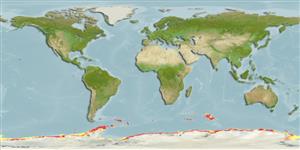>
Perciformes/Notothenioidei (Icefishes) >
Nototheniidae (Cod icefishes) > Nototheniinae
Etymology: Notothenia: Greek, 'notos', ou; νοτος, ου), from the south + Greek, 'e 'eutheneia',as or 'euthenia', as (ευθενεια, ας; ευθενια, ας), abundance (P. Romero, pers.comm. 01/16); coriiceps: coriiceps from Latin corium skin or leather plus ceps head = skin head or leather head (Ref. 11892).
More on author: Richardson.
Environment: milieu / climate zone / depth range / distribution range
Ecología
marino demersal; rango de profundidad 0 - 550 m. Polar; 46°S - 78°S, 180°W - 180°E
Southern Ocean: probably circum-Antarctic on the continental shelf. So far, known from the western Ross Sea, Balleny islands, Adélie Land, Antarctic Peninsula and associated islands, islands of the Scotia Arc to South Georgia, Weddell Sea, Bouvet, and the sub-Antarctic islands of the Indian Ocean sector.
Length at first maturity / Tamaño / Peso / Age
Maturity: Lm 36.5 range ? - ? cm
Max length : 62.0 cm TL macho / no sexado; (Ref. 5179); common length : 50.0 cm TL macho / no sexado; (Ref. 2121)
Short description
Claves de identificación | Morfología | Morfometría
Espinas dorsales (total) : 4 - 6; Radios blandos dorsales (total) : 35 - 38; Radios blandos anales: 26 - 30. Wide interorbital space, fewer pectoral rays, lack of scales below the eye (Ref. 11892).
Most commonly found in less than 200 m (Re. 5179). Stomach contents included
mainly small crustaceans (Amphipoda and Euphausiacea) and seaweeds (Ref. 122792).
Dewitt, H.H., P.C. Heemstra and O. Gon, 1990. Nototheniidae. p. 279-331. In O. Gon and P.C. Heemstra (eds.) Fishes of the Southern Ocean. J.L.B. Smith Institute of Ichthyology, Grahamstown, South Africa. (Ref. 5179)
IUCN Red List Status (Ref. 130435)
Threat to humans
Harmless
Human uses
Pesquerías: de interés potencial
Herramientas
Special reports
Download XML
Fuentes de Internet
Estimates based on models
Preferred temperature (Ref.
123201): -1.7 - 2.4, mean -0.6 °C (based on 170 cells).
Phylogenetic diversity index (Ref.
82804): PD
50 = 0.5078 [Uniqueness, from 0.5 = low to 2.0 = high].
Bayesian length-weight: a=0.00661 (0.00544 - 0.00803), b=3.22 (3.16 - 3.28), in cm total length, based on LWR estimates for this species (Ref.
93245).
Nivel trófico (Ref.
69278): 2.8 ±0.35 se; based on food items.
Resiliencia (Ref.
120179): Bajo, población duplicada en un tiempo mínimo de 4.5-14 años (Assuming tm>4).
Fishing Vulnerability (Ref.
59153): High vulnerability (60 of 100).
Climate Vulnerability (Ref.
125649): Moderate to high vulnerability (50 of 100).
Nutrients (Ref.
124155): Calcium = 20.8 [12.1, 47.6] mg/100g; Iron = 0.412 [0.189, 0.797] mg/100g; Protein = 18 [16, 20] %; Omega3 = 0.326 [0.178, 0.568] g/100g; Selenium = 18.9 [7.9, 43.2] μg/100g; VitaminA = 9.04 [2.05, 41.45] μg/100g; Zinc = 0.491 [0.330, 0.740] mg/100g (wet weight);
